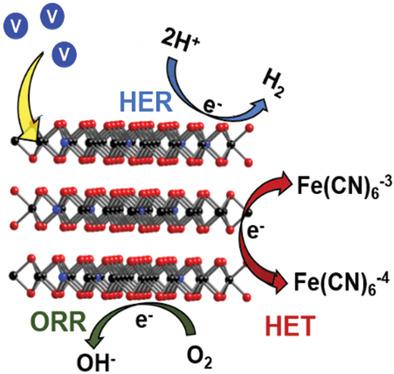当前位置:
X-MOL 学术
›
Adv. Funct. Mater.
›
论文详情
Our official English website, www.x-mol.net, welcomes your feedback! (Note: you will need to create a separate account there.)
Vanadium Dopants: A Boon or a Bane for Molybdenum Dichalcogenides‐Based Electrocatalysis Applications
Advanced Functional Materials ( IF 19.0 ) Pub Date : 2020-11-25 , DOI: 10.1002/adfm.202009083 Hui Ling Chia, Carmen C. Mayorga‐Martinez, Zdeněk Sofer, Petr Lazar, Richard D. Webster, Martin Pumera
Advanced Functional Materials ( IF 19.0 ) Pub Date : 2020-11-25 , DOI: 10.1002/adfm.202009083 Hui Ling Chia, Carmen C. Mayorga‐Martinez, Zdeněk Sofer, Petr Lazar, Richard D. Webster, Martin Pumera

|
The ever‐rising concerns with regards to energy shortages and climate change have made the search for clean and renewable energy sources a pressing priority for the sustainable development of societies. Although, conventional precious metal‐based catalysts such as platinum, iridium, and ruthenium are able to efficiently catalyze the conversion of chemical to electrical energy, they are often very costly, scarce, and suffer from poor stability, hence impeding their widespread applications. The limitations of the current state‐of art catalysts have propelled tremendous efforts in search for alternative catalysts. Notably, transition metal dichalcogenides (TMDs) have spurred much enthusiasm because of their natural abundance, low cost, and remarkable catalytic activity. Numerous studies have recounted that doping can tune the properties of TMDs and that vanadium dopants reportedly improve the electrical properties of Group 6 TMDs. Herein, the authors aspire to investigate the effects of doping varying amounts of vanadium on molybdenum dichalcogenides on their electrocatalytic activities toward hydrogen evolution reaction, oxygen evolution reaction, and oxygen reduction reaction. Despite previous studies bespeaking promising effects, the results here demonstrate both improvements and worsening of electrocatalytic performances from varying the stoichiometry of vanadium dopants in molybdenum dichalcogenides, depending on the type of materials and intended electrochemical applications.
中文翻译:

钒掺杂剂:基于硫代硫属元素化物的电催化应用中的硼或B
对能源短缺和气候变化的日益关注使寻找清洁和可再生能源成为社会可持续发展的当务之急。尽管常规的基于贵金属的催化剂(例如铂,铱和钌)能够有效地催化化学物质向电能的转化,但是它们通常非常昂贵,稀缺且稳定性差,因此阻碍了它们的广泛应用。当前最先进的催化剂的局限性促使人们为寻找替代催化剂付出了巨大的努力。值得注意的是,由于过渡金属二硫化氢(TMDs)的自然丰度,低成本和出色的催化活性,因此引起了极大的热情。大量研究表明,掺杂可以调节TMD的性能,据报道钒掺杂剂可以改善6组TMD的电性能。本文中,作者希望研究在二卤化钼钼上掺杂不同量的钒对它们对氢释放反应,氧释放反应和氧还原反应的电催化活性的影响。尽管先前的研究表明其前景可观,但这里的结果表明,根据材料的类型和预期的电化学应用,通过改变二硫化钼钼中钒掺杂剂的化学计量,可以改善和降低电催化性能。作者希望研究在二卤化钼钼中掺杂不同量的钒对它们对氢释放反应,氧释放反应和氧还原反应的电催化活性的影响。尽管先前的研究表明其前景可观,但这里的结果表明,根据材料的类型和预期的电化学应用,通过改变二硫化钼钼中钒掺杂剂的化学计量,可以改善和降低电催化性能。作者希望研究在二卤化钼钼中掺杂不同量的钒对它们对氢释放反应,氧释放反应和氧还原反应的电催化活性的影响。尽管先前的研究表明其前景可观,但这里的结果表明,根据材料的类型和预期的电化学应用,通过改变二硫化钼钼中钒掺杂剂的化学计量,可以改善和降低电催化性能。
更新日期:2020-11-25
中文翻译:

钒掺杂剂:基于硫代硫属元素化物的电催化应用中的硼或B
对能源短缺和气候变化的日益关注使寻找清洁和可再生能源成为社会可持续发展的当务之急。尽管常规的基于贵金属的催化剂(例如铂,铱和钌)能够有效地催化化学物质向电能的转化,但是它们通常非常昂贵,稀缺且稳定性差,因此阻碍了它们的广泛应用。当前最先进的催化剂的局限性促使人们为寻找替代催化剂付出了巨大的努力。值得注意的是,由于过渡金属二硫化氢(TMDs)的自然丰度,低成本和出色的催化活性,因此引起了极大的热情。大量研究表明,掺杂可以调节TMD的性能,据报道钒掺杂剂可以改善6组TMD的电性能。本文中,作者希望研究在二卤化钼钼上掺杂不同量的钒对它们对氢释放反应,氧释放反应和氧还原反应的电催化活性的影响。尽管先前的研究表明其前景可观,但这里的结果表明,根据材料的类型和预期的电化学应用,通过改变二硫化钼钼中钒掺杂剂的化学计量,可以改善和降低电催化性能。作者希望研究在二卤化钼钼中掺杂不同量的钒对它们对氢释放反应,氧释放反应和氧还原反应的电催化活性的影响。尽管先前的研究表明其前景可观,但这里的结果表明,根据材料的类型和预期的电化学应用,通过改变二硫化钼钼中钒掺杂剂的化学计量,可以改善和降低电催化性能。作者希望研究在二卤化钼钼中掺杂不同量的钒对它们对氢释放反应,氧释放反应和氧还原反应的电催化活性的影响。尽管先前的研究表明其前景可观,但这里的结果表明,根据材料的类型和预期的电化学应用,通过改变二硫化钼钼中钒掺杂剂的化学计量,可以改善和降低电催化性能。



























 京公网安备 11010802027423号
京公网安备 11010802027423号